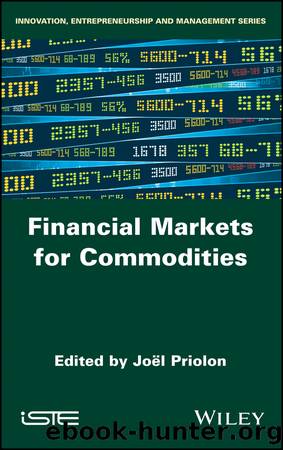Financial Markets for Commodities by Unknown

Author:Unknown
Language: eng
Format: epub
Publisher: John Wiley & Sons, Incorporated
Published: 2019-01-07T00:00:00+00:00
Figure 5.1. The interposition of a clearing house between the writer and the holder of the option
Some time later, at a point in time t = Ï , for some reason, Y re-sells the option to Z, at a price CÏ ; no new contract is created as this simply involves the ceding of an existing contract. The transaction can then be represented in Figure 5.2.
Figure 5.2. The interposition of a clearing house between a holder and a buyer
At this time, the situation is studied by the clearing house, which notes that Y has ceded the option that they owned. Consequently, Y is no longer engaged on the market and the gain generated by their operation amounts to q(CÏ â C0), with q being the quantity of the underlying entity covered by an option. In order to be perfectly rigorous, the flow must be updated to a single date. Let us also recall that here we are only considering a single option; thus, q(pÏ â p0) represents a unit gain. If Y was committed to n options, the gain or loss would be n à q(CÏ â C0). X is still committed as the writer, while Z is now the holder of an option that they will exercise if the price of the underlying entity at the time of the maturity allows them to realize a profit. Consequently, X may also pull away by buying an option. As X will simultaneously be the writer and holder of an option, this is equivalent to their quitting the market.
Let us now consider the market maturing on the date T and let us assume that n options remain open. For ease of discussion, we will also assume that each player writes or holds only one option; there are, therefore, n writers, denoted by Wi and n holders, denoted by Hi, for i ϵ {1, â¦, n}. We will finally assume that the options are in the money at the time of maturity and that the holders will exercise them. Let us recall an important point: on an exchange, the holders and writers entered into a contract through the intermediary of the clearing house, which means that they are not in a bilateral contractual relationship. In practice, it is the clearing house that will âmatchâ the writers and holders upon maturity. Let us consider, for example, that the holder Dk is matched with the writer Wj: both these players will enter into a negotiation phase to execute the contract that now directly connects them. The execution will be the focus of a negotiation and, eventually, both players may agree upon modalities other than those provided in the contract. For example, the delivery site of the commodities may be different from the sites given in the contract. Nonetheless, if Dk and Wj are unable to reach an agreement, then the initial terms of the contract will be retained and the clearing house will guarantee the completion of the transaction. Among the conventional elements of negotiation, we have the choice between a physical delivery and a cash settlement.
Download
This site does not store any files on its server. We only index and link to content provided by other sites. Please contact the content providers to delete copyright contents if any and email us, we'll remove relevant links or contents immediately.
| Corporate Finance | Crowdfunding |
| Financial Engineering | Financial Risk Management |
| Wealth Management |
The Black Swan by Nassim Nicholas Taleb(6190)
Bad Blood by John Carreyrou(5769)
Pioneering Portfolio Management by David F. Swensen(5606)
Millionaire: The Philanderer, Gambler, and Duelist Who Invented Modern Finance by Janet Gleeson(3569)
Skin in the Game by Nassim Nicholas Taleb(3460)
The Money Culture by Michael Lewis(3284)
Skin in the Game: Hidden Asymmetries in Daily Life by Nassim Nicholas Taleb(3264)
Bullshit Jobs by David Graeber(3180)
The Wisdom of Finance by Mihir Desai(3078)
Blockchain Basics by Daniel Drescher(2891)
Liar's Poker by Michael Lewis(2811)
The Intelligent Investor by Benjamin Graham Jason Zweig(2596)
Hands-On Machine Learning for Algorithmic Trading by Stefan Jansen(2518)
Mastering Bitcoin: Programming the Open Blockchain by Andreas M. Antonopoulos(2511)
Investing For Dummies by Eric Tyson(2470)
Fooled by Randomness: The Hidden Role of Chance in Life and in the Markets by Nassim Nicholas Taleb(2413)
The Power of Broke by Daymond John(2376)
Zero Hour by Harry S. Dent Jr. & Andrew Pancholi(2246)
Market Wizards by Jack D. Schwager(2163)
